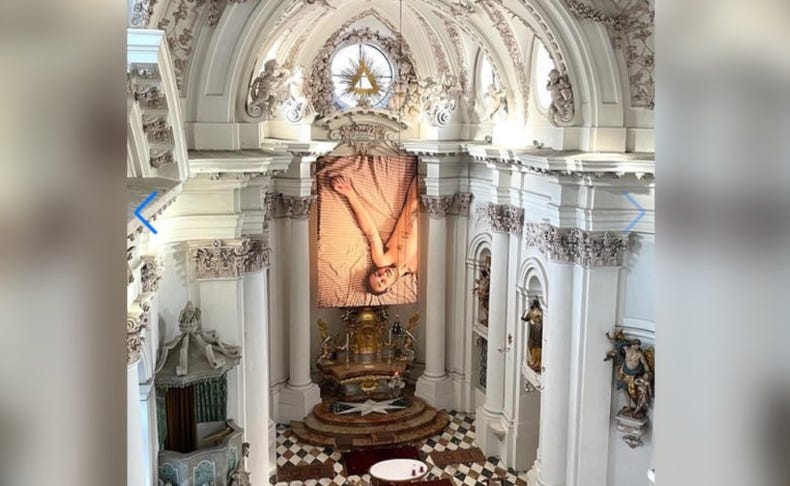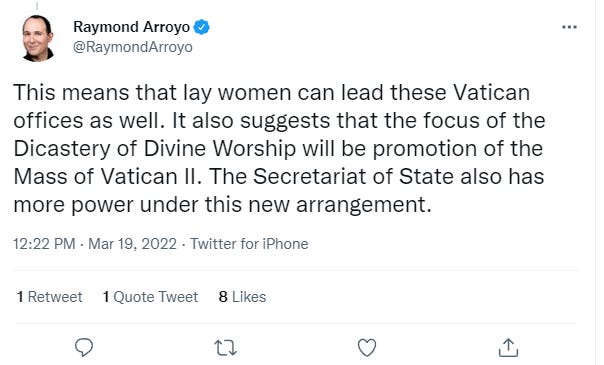Sacrilegious: Bishop Promotes Trans Activist Over Altar
Blessed Solemnity of St. Joseph, spouse of the Virgin Mary and foster father of Jesus! Unfortunately, on this holy day, sacrilegious behavior is reportedly happening in a historic church in Austria—and the pope has been pushing the doctrinal envelope again.
An Austrian bishop has hung a naked image of a homosexual/trans activist over his altar. The Bible teaches that homosexuality and sexual sin of any sort are barriers to reaching Heaven. St. Paul says: “Do not err: neither fornicators, nor idolaters, nor adulterers, nor the effeminate, nor liers with mankind, nor thieves, nor covetous, nor drunkards, nor railers, nor extortioners, shall possess the kingdom of God.” —1 Cor. 6:9-10. As I have previously explained:
“The word being translated here ‘liers with mankind’ in the original Greek, ἀρσενοκοῖται, means literally ‘men engaged in sexual activity with the same sex.’ St. Paul’s condemnation of homosexuality is perfectly in accord with the Old Testament as well. The reason homosexuality used to be called ‘sodomy’ was because the towns of Sodom and Gomorrah were destroyed by God because of their sexual perversion, particularly homosexuality (which is highlighted in Genesis).”
Transgenderism, as a similar form of sexual perversion, is also condemned by the Catholic Church. Promotion of a homosexual/trans activist is bad enough, but to glorify sin above the altar seems sacrilegious. The Bible says in Exodus 20:26 (while speaking about not defiling the altar), “Thou shalt not go up by steps unto my altar, lest thy nakedness be discovered.” To be specific, the verse condemns approaching the altar in a way that might expose certain parts of the body that should be hidden. In other words, it defiles the altar to expose oneself before it in an inappropriate fashion. The naked image the Austrian bishop hung over his altar certainly sure seems to fall into that category.
“[LifeSiteNews] Austrian bishop hangs banner of nude trans activist over main altar for Lent
The model's Instagram account shows many equivocal pictures of trans men, tortured faces, and homosexuals kissing, as well as a post about how abortion is a 'sacral' act
The Catholic bishop of Innsbruck, Austria, inaugurated a ‘Lenten’ decoration of the main altar of the historic University church of Saint John Nepomuk, a baroque jewel from the early 18th century. The ‘decoration’ shows an enlarged partial inverted photograph of a naked young man with scars and tattoos lying on a bed and has been placed as an altarpiece above the tabernacle of the former main altar of the church. The piece of contemporary art by Carmen Brucic was specially chosen by Bishop Hermann Glettler, and bears the title: ‘Tired.’
Bishop Glettler has campaigned for the blessing of same-sex couples in the past. . .
In itself, the more-than-life-size picture (4.5 by 3 meters) is completely incongruous over an altar because it has no religious meaning. But the picture of this nude young man lying on his back in an exhausted attitude, barely missing the display of his genitalia, is doubly scandalous. Besides its obvious indecency in such a setting, it portrays a prominent figure of the ‘queer’ scene in Tbilisi, thus openly glorifying a ‘gay’ activist from Georgia whose image will remain over the tabernacle holding the Real Presence of Our Lord in the Eucharist until the end of Lent.
The said young man, David Apakidze, 23, is half Georgian, half Ukrainian – a somewhat obvious way of presenting the photo installation as a reflection on the current Russian invasion of Ukraine. But he is better known as an activist of the Bassiani club where Georgian homosexuals, drag queens and other self-proclaimed promoters of sexual deviancy had found a ‘safe space’ for techno music, rave parties, and ‘LGBTQ’ performances. The club was founded in 2014 and hosted performances that can only be qualified as hellish. In May 2018, the club was raided by police and closed. Many later joined a public protest dubbed ‘rave-o-lution days’ with crowds dancing non-stop in the streets to techno music. The club was reopened but closed again for many months due to COVID restrictions.
At this time, Apakidze became a member of the ‘queer Georgian art collective’ dedicated to ‘destroying toxic social norms.’
‘Tbilisi-based queer art collective Fungus thrive amid hostility. By creating unapologetically bold art and a supportive community, the group of 20 artists are carving out a safe space for queer youth in a society seeking to marginalize them. ‘Fungus thrives in damp and dark places,’ the group’s manifesto reads. . .
‘Fungus,’ ‘a very left-wing, liberal base’ was formed to hold a queer art show alongside the Tbilisi Mercedes-Benz fashion week one year ago. The plan was stalled by COVID restrictions but the group went on to organize many events linked to the ‘Rave Revolution.’
This is where Carmen Brucic, the Tyrolean photographer who was approached by Bishop Glettler to contribute to his ‘tired? lost? displaced?’ art show that consists in the display of three ‘installations’ in as many churches in Innsbruck this Lent. The bishop appears to have appreciated an exhibition she set up at the Tbilisi Photo Festival in Georgia in the summer of 2021: under the title ‘Private Stages,’ it portrayed five activists of the ‘Rave Revolution.’ Apakidze was one of them.
Brucic chose to shoot her pictures of the young man in all his ‘fragility,’ lying naked on a bed, adopting different poses. The photo chosen by Bishop Glettler focuses on Apakidze’s inclined face, chest and outstretched arm in a way that apes an inverted Crucifixion, showing the activist’s pierced nipple and multiple tattoos and scars on his inner arms due to self-harm. . .
Apakidze’s own Instagram account. . .includes the photograph of a contemporary art exhibit labeled “Abortion Pills” set up – according to the “artist” – as “a corner of the icons of the Virgin Mary, which is an advertising campaign for abortion pills.’
‘Abortion is a sacral act in which a woman reclaims the right to reproduce,’ Apakidze further comments.
This man’s picture is now hiding the baroque altarpiece of an Austrian church, with the dubious blessing of the local bishop who not only inaugurated the work together with Carmen Brucic last Tuesday, but who claims full responsibility for choosing and organizing what must be a blasphemous installation, given the context.”
The bishop has also encouraged openly heretical actions such as same-sex unions and the “ordination” of women as priests. But perhaps in the latter case Pope Francis, the same pope who has often attacked or undermined aspects of traditional Catholicism or even doctrines before, might be sympathetic; Francis has reportedly taken a move which at least borders on the doctrinally questionable.
“Nine years after taking office, Pope Francis promulgated his constitution reforming [or rather revolutionizing] the Roman Curia, a project he began with his international College of Cardinals shortly after taking office in 2013. . .
Part of that effort, he wrote, requires including more laypeople in Curia leadership positions.”
As Catholic reporter Raymond Arroyo explained on Twitter:
Why is it such a problem that women could be in charge of Vatican offices? For the same reason girl altar boys are problematic. Women cannot be Catholic priests because a priest has to act in persona Christi (in the person of Christ), and God very specifically became flesh as a man; furthermore, only men were present at the Last Supper and the Upper Room after Easter, when Christ gave the priestly powers. This is NOT sexism. The greatest saint in the Catholic Church, so high she has a species of honor only given to her and to no other saints, is the Blessed Virgin Mary; and Jesus specifically broke societal barriers of his time to reach out to and be friends with women. In the Catholic Church the highest office is, in a way, sainthood (very clearly attainable by both sexes)—and so it is not insulting to women that they are not priests. But as women cannot be clergy, and as it is better to have the most important offices in the Church run by clergy, allowing laypeople—including women—to be in charge of the offices is certainly questionable at best, cleverly revolutionary at worst.




